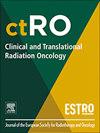头颈癌低危CTV-P2划定的GORTEC调查
IF 2.7
3区 医学
Q3 ONCOLOGY
引用次数: 0
摘要
目的:2018年建立了一项国际共识,将GTV-P周围几何(5 + 5mm)扩张用于头颈部鳞状细胞癌(HNC)最终放疗的实践标准化。GORTEC(法国HNC肿瘤和放疗组)进行了一项调查,以评估使用“正式共识方法”对CTV-P2划定的一致程度。方法将2018共识CTV-P2的32份提案和另外6份GORTEC提案提交给13名GORTEC放射肿瘤学家(RO)。提案的中位数得分≥7分为“适合”,分数≤3.5分为“不适合”或“不确定”。一致性程度分为高(≥85%)、中等(75 - 84%)和低(< 75%)。其他40名主任审查了合适的建议,以提出最后建议。结果2018年的提案“不确定”,一致性程度较低(41.5 - 69%),但T1肿瘤的一致性为89%。GORTEC的6个提案中有5个是“合适的”,1个是“不确定的”。97.5%的RO认为最终的建议是“合适和保留”,如下:为了获得CTV-P2, GORTEC建议采用“地理解剖学”方法。使用几何概念,将10mm各向同性边缘应用于GTV,适用于除下咽以外的所有位置(前后、外侧和颅侧各10mm)。CTV-P2使用解剖学概念(解剖学障碍,传播途径)进一步修改,并考虑利益/风险平衡和危险器官的接近性。GORTEC调查源自2018年国际CTV-Ps划定共识,建议采用“地理解剖学”方法划定HNC中CTV-P2。本文章由计算机程序翻译,如有差异,请以英文原文为准。
A GORTEC survey on low-risk CTV-P2 delineation in head and neck cancers
Purpose
An international consensus was established in 2018 to standardise practice using geometric (5 + 5 mm) expansion around GTV-P for definitive radiotherapy of squamous cell carcinomas of the head and neck (HNC). The GORTEC (French HNC Oncology and Radiotherapy Group) conducted a survey to assess the level of agreement about CTV-P2 delineation using a “formalised consensus method”.
Methods
The 32 proposals of the 2018 consensus on CTV-P2 and 6 additional GORTEC proposals were submitted to 13 GORTEC radiation oncologists (RO). Proposals were rated as “suitable” for median scores ≥7, “unsuitable” for scores ≤3.5 or “uncertain.” The degree of agreement was high (≥85 %), moderate (75–84 %) or low (<75 %). Suitable proposals were reviewed by 40 other RO for final recommendations.
Results
The 2018 proposals were “uncertain” with low degrees of agreement (41.5–69 %), except for T1 tumors, which had 89 % agreement. Five out of 6 GORTEC proposals were “suitable” and one “uncertain.” The final recommendation was “suitable and to be retained” by 97.5 % of RO, as follows: To obtain CTV-P2, GORTEC recommends applying a “geo-anatomical” approach. Using the geometric concept, 10 mm-isotropic margins are applied to the GTV, for all locations but the hypopharynx (10 mm antero-posterior, laterally and 15 mm craniocaudally). CTV-P2 is further modified using the anatomical concept (anatomical barriers, dissemination routes) and accounting the benefit/risk balance and proximity of organs at risk.
Conclusion
The GORTEC survey derived from the 2018 international CTV-Ps delineation consensus suggests a “geo-anatomical” approach for the delineation of CTV-P2 in HNC.
求助全文
通过发布文献求助,成功后即可免费获取论文全文。
去求助
来源期刊

Clinical and Translational Radiation Oncology
Medicine-Radiology, Nuclear Medicine and Imaging
CiteScore
5.30
自引率
3.20%
发文量
114
审稿时长
40 days
 求助内容:
求助内容: 应助结果提醒方式:
应助结果提醒方式:


